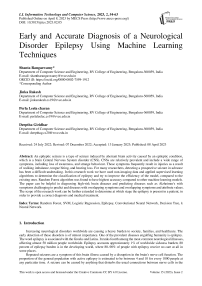Early and Accurate Diagnosis of a Neurological Disorder Epilepsy Using Machine Learning Techniques
Автор: Shanta Rangaswamy, Jinka Rakesh, Perla Leela charan, Deeptha Giridhar
Журнал: International Journal of Information Technology and Computer Science @ijitcs
Статья в выпуске: 2 Vol. 15, 2023 года.
Бесплатный доступ
An epileptic seizure is a type of seizure induced by aberrant brain activity caused by an epileptic condition, which is a brain Central Nervous System disorder (CNS). CNSs are relatively prevalent and include a wide range of symptoms, including loss of awareness, and strange behaviour. These symptoms frequently result in injuries as a result of walking imbalance, tongue biting, and hearing loss. For many researchers, detecting a prospective seizure in advance has been a difficult undertaking. In this research work we have used non-imaging data and applied supervised learning algorithms to determine the classification of epilepsy and try to improve the efficiency of the model, compared to the existing ones. Random Forest algorithm was found to have highest accuracy compared to other machine learning models. The paper can be helpful in diagnosing high-risk brain diseases and predicting diseases such as Alzheimer's with symptoms challenging to predict and diseases with overlapping symptoms and overlapping symptoms and attribute values. The scope of the research work can be further extended to determine at which stage the epilepsy is present in a patient, in order to provide a correct diagnosis and medical treatment.
Random Forest, SVM, Logistic Regression, Epilepsy, Convolutional Neural Network, Decision Tree, k Neural Network
Короткий адрес: https://sciup.org/15018929
IDR: 15018929 | DOI: 10.5815/ijitcs.2023.02.05
Список литературы Early and Accurate Diagnosis of a Neurological Disorder Epilepsy Using Machine Learning Techniques
- Ali H. Shoeb, John V. Guttag, - ICML, 2010 - openreview.net. Massachusetts Institute of Technology, 77 Massachusetts Avenue, Cambridge, Massachusetts, 02139. Application of Machine Learning to Epileptic Seizure Detection.
- Sandeep Kumar Satapathy , Satchidananda Dehuri - International Journal of Applied Engineering Research ISSN 0973-4562 Volume 11, Number 1 (2016) pp 120-129,Research India Publications. http://www.ripublication.com
- Gautama T, Mandic DP, Van Hulle MM. Indications of nonlinear structures in brain electrical activity. Phys Rev E 2003; 67:046204.
- Nigam VP, Graupe D. A neural-network-based detection of epilepsy. Neurol Res 2004; 26:55–60.
- Güler I, Übeyli ED. Adaptive neuro-fuzzy inference system for classification of E.E.G. signals using wavelet coefficients. J Neurosci Methods 2005; 148:113–21.
- Adeli H, Ghosh-Dastidar S, Dadmehr N. A wavelet-chaos methodology for the analysis of E.E.G.s and E.E.G. Sub-Bands to detect seizures and epilepsy. IEEE (InstElectr Electron Eng) Trans Biomed Eng 2006. https://doi.org/10.1109/TBME.2006.886855.
- Orhan U, Hekim M, Ozer M. E.E.G. signals classification using the K means clustering and a multilayer perceptron neural network model. Expert Syst Appl 2011; 38:13475–81.
- Alickovic E, Kevric J, Subasi A. Performance evaluation of empirical mode decomposition, discrete wavelet transform, and wavelet packed decomposition for automated epileptic seizure detection and prediction. Biomed Signal Process Contr 2018; 39:94–102.
- Subasi Abdulhamit, Kevric Jasmin, Abdullah Canbaz M. Epileptic seizure detection using hybrid machine learning methods. Neural Comput Appl 2019;31(1):317–25.
- Hussain Lal. Detecting epileptic seizures with different feature extracting strategies using robust machine learning classification techniques by applying advance parameter optimization approach. Cognitive Neurodynamics 2018;12(3):271–94
- J. T. Turner, Adam Page, Tinoosh Mohsenin, and Tim Oates. 2014. Deep belief networks used on high-resolution multichannel electroencephalography data for seizure detection. In 2014 AAAI Spring Symposium Series
- Almustafa, Khaled Mohamad. "Classification of epileptic seizure dataset using different machine learning algorithms." Informatics in Medicine Unlocked 21 (2020): 100444. [https://archive.ics.uci.edu/ml/datasets/Epileptic%2BSeizure%2BRecognition]
- İlkay Yıldız, Rachael Garner, Matthew Lai, Dominique Duncan. “Unsupervised seizure identification on EEG”, Vol 1, 1 September 2021. https://doi.org/10.1016/j.cmpb.2021.106604.
- Khansa Rasheed, Adnan Qayyum, Junaid Qadir - Machine Learning for Predicting Epileptic Seizures Using EEG Signals: A Review, ISSN - 1937-3333, Vol 14, 13thJuly,2020. IEEE. 10.1109/RBME.2020.3008792.
- Sai Manohar Beeraka, Abhash Kumar, Mustafa Sameer, Sanchita Ghosh & Bharat Gupta, Accuracy Enhancement of Epileptic Seizure Detection: A Deep Learning Approach with Hardware Realization of STFT, Circuits Syst Signal Process 41, 461–484 (2022). https://doi.org/10.1007/s00034-021-01789-4 , 3rd July, 2021.
- Karpov, Oleg E., Vadim V. Grubov, Vladimir A. Maksimenko, Semen A. Kurkin, Nikita M. Smirnov, Nikita P. Utyashev, Denis A. Andrikov, Natalia N. Shusharina, and Alexander E. Hramov. "Extreme value theory inspires explainable machine learning approach for seizure detection." Scientific Reports 12, no. 1 (2022): 1-14.
- Shoeibi, Afshin, Parisa Moridian, Marjane Khodatars, Navid Ghassemi, Mahboobeh Jafari, Roohallah Alizadehsani, Yinan Kong et al. "An overview of deep learning techniques for epileptic seizures detection and prediction based on neuroimaging modalities: Methods, challenges, and future works." Computers in Biology and Medicine (2022): 106053.


